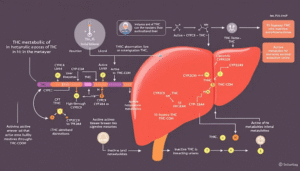Wondering which cognitive enhancer is right for you? This article compares modafinil vs adderall in terms of effectiveness, uses, and side effects to help you decide.
Key Takeaways
- Modafinil is primarily used for excessive daytime sleepiness, while Adderall is used for ADHD and narcolepsy, with both having distinct mechanisms and off-label applications.
- Modafinil has a lower risk of addiction and is classified as a Schedule IV controlled substance, whereas Adderall carries a higher addiction potential and is a Schedule II controlled substance.
- Consultation with a healthcare professional is essential to evaluate individual health conditions and personal lifestyle factors when choosing between Modafinil and Adderall.
Overview of Modafinil and Adderall
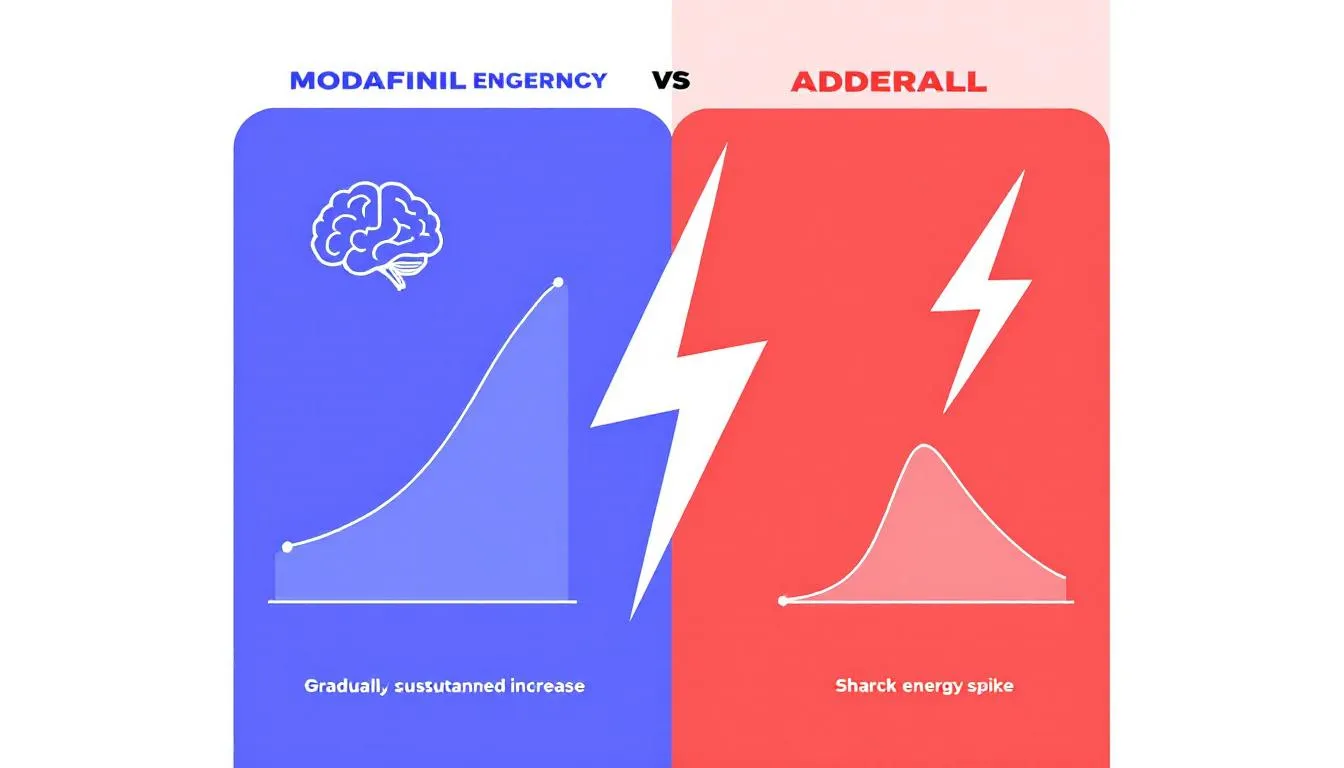
First introduced in France in 1986 and FDA-approved in the U.S. by 1998, Modafinil treats excessive daytime sleepiness linked to narcolepsy, shift work sleep disorder, and obstructive sleep apnea. Marketed as the brand name provigil, it enhances wakefulness.
Approved by the FDA in 1996, Adderall treats ADHD and narcolepsy. Available as Adderall IR (immediate-release) and Adderall XR (extended-release), it is a central nervous system stimulant like Modafinil, yet with distinct mechanisms and effects, making the selection critical for effective treatment.
Primary Uses and Off-Label Applications
While Modafinil is FDA-approved for narcolepsy, shift work sleep disorder, and obstructive sleep apnea, Adderall is mainly used for ADHD and narcolepsy. Both medications are also popular for off-label uses.
Modafinil is commonly used off-label for ADHD, while Adderall is sometimes prescribed for weight management and improved alertness. Both have proven effective in reducing ADHD symptoms, leading to discussions around how to treat adhd, adderall modafinil vs Adderall.
Understanding Off-Label Use
Off-label prescribing involves using a drug for non-FDA-approved conditions. For instance, Modafinil might be prescribed off label for:
- Parkinson’s disease
- Chronic fatigue syndrome
- Depression
- Multiple sclerosis-related fatigue.
While the effectiveness and safety of these off-label uses are not fully established, they offer additional therapeutic options for patients.
Mechanisms of Action
Modafinil enhances wakefulness by stimulating neurotransmitter systems such as norepinephrine and serotonin, effects modafinil affecting levels of serotonin, dopamine, glutamate, histamine, and GABA. These changes improve cognitive functions like attention and wakefulness.
Adderall boosts dopamine, serotonin, and norepinephrine levels, increasing alertness and focus by enhancing neurotransmitters crucial for attention and executive function in individuals with attention deficit hyperactivity disorder. Central nervous system stimulants, including amphetamine salts, play a significant role in this process.
While both Modafinil and Adderall are effective cognitive enhancers due to their psychoactive effects and impact on cognitive function, their distinct mechanisms may make them suitable for different individuals and conditions.
Effectiveness for Treating Conditions

Recognized for treating sleep disorders such as obstructive sleep apnea and narcolepsy, Modafinil is strongly endorsed by the American Academy of Sleep Medicine for treating narcolepsy due to its effectiveness to treat excessive sleepiness caused by managing excessive daytime sleepiness.
Adderall is the only FDA-approved medication for ADHD medications. Regarding treatment for narcolepsy and ADHD:
- Both Modafinil and Adderall treat narcolepsy.
- Comparative effectiveness of Modafinil and Adderall for ADHD is still being explored.
- Research suggests Modafinil may reduce ADHD symptoms as effectively as Adderall.
Safety and Side Effects
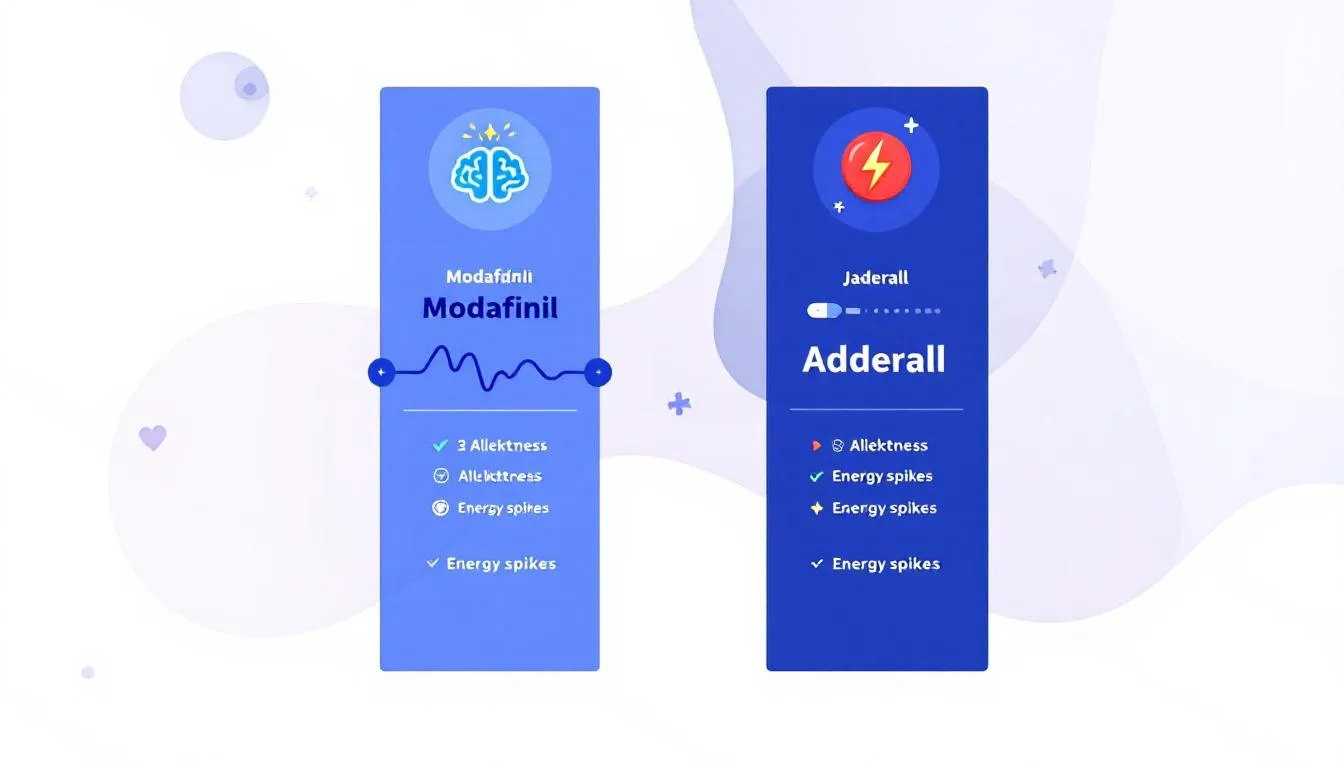
Safety is a major concern with cognitive enhancers. Modafinil can cause serious side effects such as:
- Chest pain
- Irregular heartbeat
- Severe allergic reactions
- Psychiatric symptoms such as anxiety or hallucinations.
Adderall also has risks. Long-term use can cause psychological issues such as anxiety and depression, especially if stopped suddenly. Prolonged use may lead to neurotoxic effects, particularly affecting dopamine-producing neurons in the brain.
Modafinil Side Effects
Common side effects of Modafinil include headaches, nausea, and anxiety, along with rhinitis, back pain, insomnia, and gastrointestinal discomfort. Rare but serious side effects include life-threatening rashes, Stevens-Johnson Syndrome, and hypersensitivity syndrome.
Monitoring the effects of Modafinil is crucial for individuals with chronic conditions like obstructive sleep apnea or shift work sleep disorder to avoid severe adverse reactions.
Adderall Side Effects
Adderall’s common side effects include loss of appetite and dry mouth, along with high blood pressure spikes, insomnia, headache, and abdominal pain. Severe risks include dependency, mental health effects, and major cardiovascular events like sudden death and heart attacks.
Due to the potential for abuse adderall and severe withdrawal symptoms, Adderall requires careful monitoring, especially for individuals with a significant risk history of substance abuse.
Dosage Guidelines
Proper dosing is crucial to maximize benefits and minimize risks. Both medications often start at lower dosages to allow for individual adjustments. Modafinil typically begins at 200 mg, while Adderall’s immediate-release form may start at 5 mg.
Dosages can be adjusted based on physician recommendations and patient needs. Modafinil typically ranges from 100 mg to 400 mg per day, while Adderall varies from 5 mg to 40 mg per day, depending on the formulation.
Modafinil Dosage
For narcolepsy and obstructive sleep apnea, the usual adult dose of Modafinil is 200 mg once daily, with a maximum of 400 mg. Older patients may need a reduced dose and close monitoring to avoid side effects.
For shift work sleep disorder, taking Modafinil about an hour before starting work can help maintain normal sleeping hours and improve wakefulness, particularly for those experiencing shift work disorder and narcolepsy shift work disorder.
Adderall Dosage
Adderall is available as immediate-release tablets and extended-release capsules (Adderall XR). Adderall IR comes in doses from 5 mg to 30 mg and is typically taken multiple times a day, starting in the morning.
Adderall XR is usually taken once daily in the morning, with or without food, and provides extended coverage for up to 12 hours. High-fat meals can slow the absorption of Adderall IR, so meal timing should be considered.
Who Should Avoid These Medications?
Certain individuals should avoid Modafinil or Adderall due to specific health risks. Those with cardiovascular issues should be cautious with Adderall, and pregnant women or those planning to become pregnant should avoid Modafinil.
Individuals with a personal or family history of substance abuse should avoid Adderall due to its higher potential for dependence and abuse. Those with severe anxiety or agitation should also avoid Adderall to prevent symptom worsening.
Potential for Abuse and Dependence
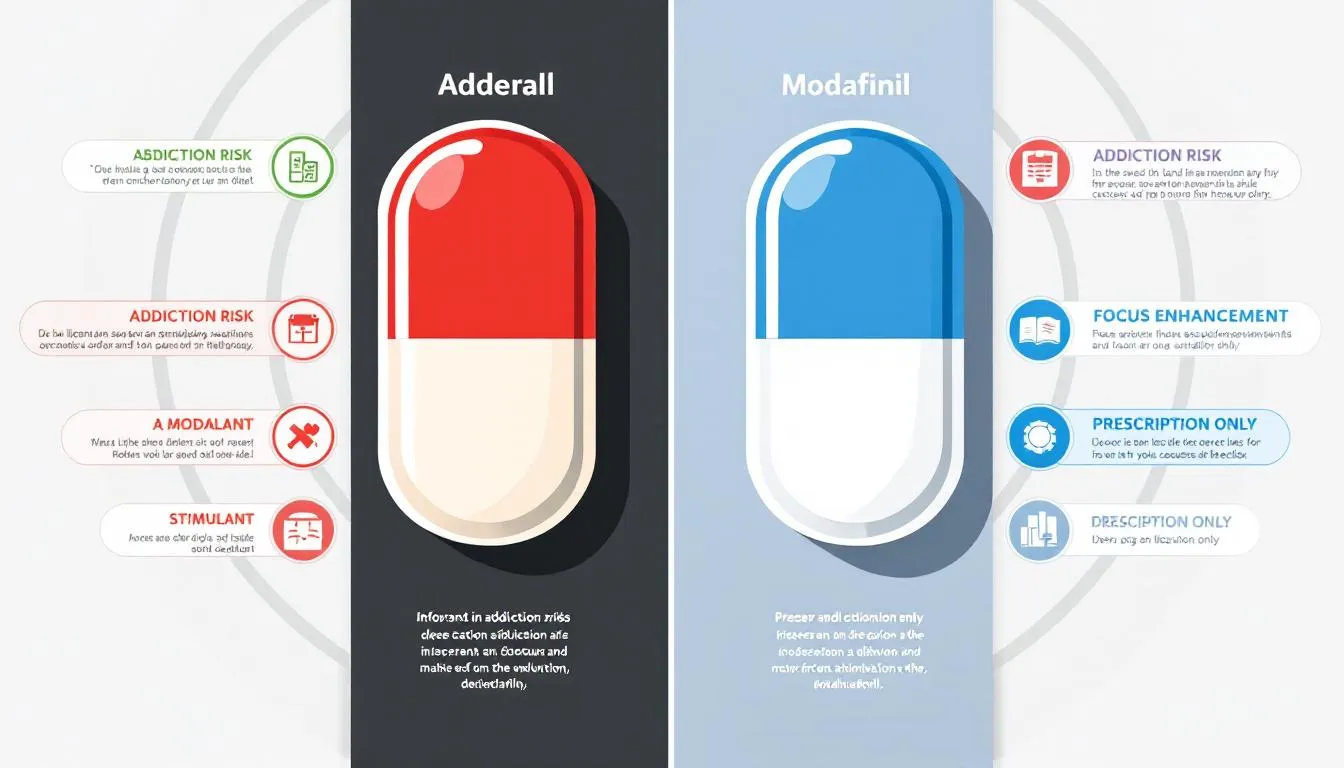
Modafinil and Adderall differ in their addiction risks and regulatory classification:
- Modafinil is a Schedule IV controlled substance with a lower risk of addiction.
- Adderall is a Schedule II controlled substance with a higher abuse potential due to its amphetamine content.
- Discontinuing Adderall can lead to significant withdrawal symptoms.
Although Modafinil generally has fewer dependency issues and withdrawal symptoms, both drugs can be misused for cognitive enhancement. Long-term Adderall use can create a tolerance cycle, requiring increased dosages for the same effects.
Drug Interactions
Consult a healthcare provider when considering multiple prescription medications and prescription stimulants, as well as other stimulants. Inform them about all prescriptions and OTC drugs being taken to avoid dangerous interactions.
Some important considerations regarding medications and Adderall include:
- Some medications can increase the risk of serotonin syndrome with Adderall.
- Combining Adderall and Modafinil may require monitoring due to minor interactions.
- Modafinil can alter the concentration of other drugs in the bloodstream, requiring careful management.
Comparing Cost and Accessibility
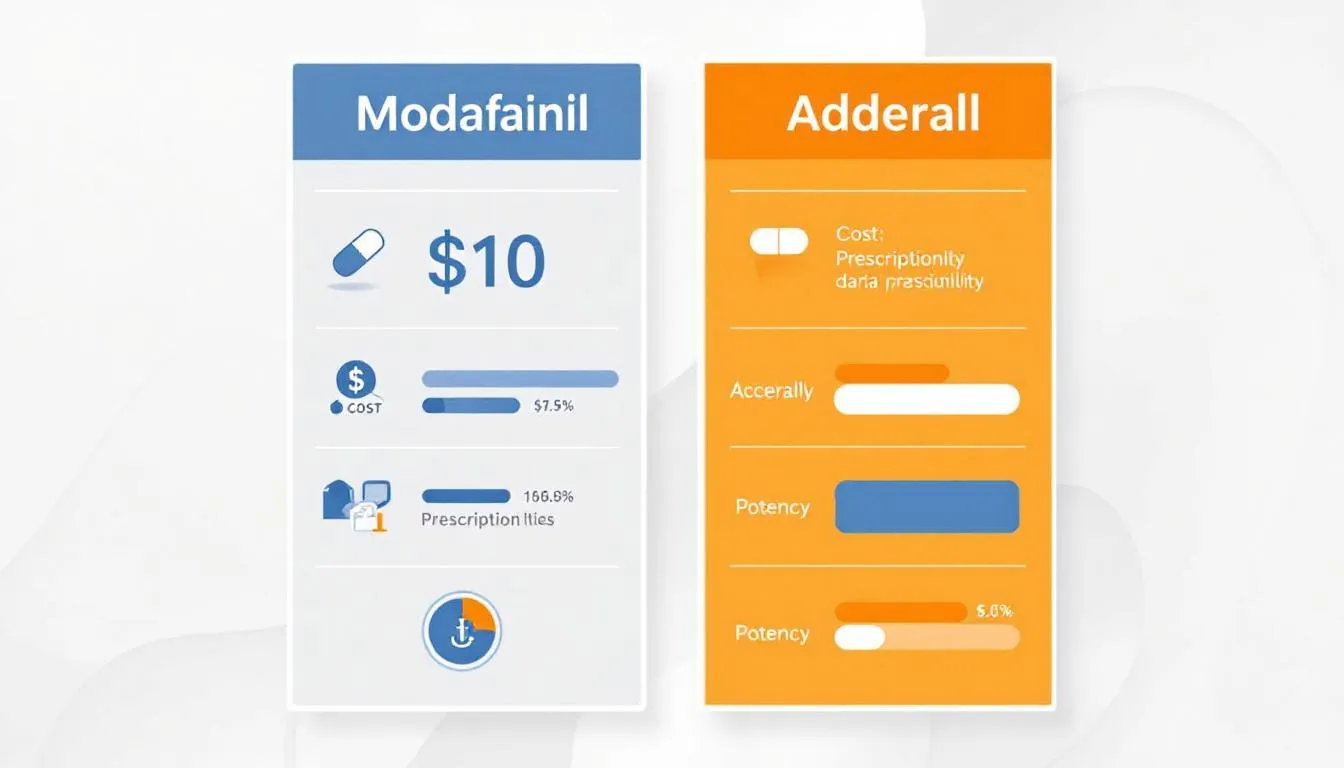
Modafinil and Adderall have the following cost and insurance considerations:
- Modafinil is available as a lower-cost generic option, making it more affordable for some patients.
- Adderall also has a generic form, reducing overall costs for consumers.
- Insurance coverage for Adderall may vary significantly, with stricter regulations compared to Modafinil.
This can make Modafinil more accessible due to fewer restrictions.
Lifestyle Considerations
Lifestyle factors like alcohol consumption significantly impact the effectiveness and side effects of Modafinil and Adderall. Mixing Modafinil with alcohol can mask alcohol’s sedative effects, leading to excessive drinking.
Moreover, how each medication affects sleep patterns can influence the decision-making process.
Alcohol and Stimulants
Using Adderall with alcohol can increase the risk of cardiovascular side effects. Patients should limit alcohol intake while on Adderall to avoid heart-related issues. Alcohol can also enhance Modafinil’s side effects, leading to unpredictable interactions.
Minimize alcohol consumption and consult a healthcare provider when using these medications.
Long-Term Usage Concerns
Chronic stimulant use can lead to stimulant effects such as:
- Tolerance, requiring higher doses over time.
- Diminished efficacy in long-term users, necessitating treatment adjustments.
- Increased potential for habit-forming behavior and dependence, including stimulant addiction and stimulant abuse.
Withdrawal from Adderall may include depression and significant withdrawal effects, as well as extreme tiredness. Higher risks of physical dependence with Adderall use include notable withdrawal effects. Understanding these risks is crucial for long-term use considerations.
Which is Right for You?
Consulting a healthcare professional is vital for evaluating individual health conditions and medication responses before deciding on Adderall or Modafinil. Medical history is crucial in determining the suitability of either medication for effective treatment.
Personal factors like work schedule and daily responsibilities can influence the choice between Adderall and Modafinil. A personalized approach ensures the chosen medication aligns with your health goals and lifestyle.
Summary
Choosing between Modafinil and Adderall involves a thorough understanding of their uses, mechanisms, effectiveness, and safety profiles. Modafinil, primarily used for treating narcolepsy and other sleep disorders, offers fewer dependency issues and is generally considered safer for long-term use,. Adderall, a potent medication for ADHD, carries a higher risk of abuse and dependence but remains the only FDA-approved medication for treating ADHD,.
Both medications have their place in managing various conditions, but the right choice depends on your specific health needs and lifestyle considerations. Consulting with a healthcare professional ensures that you receive personalized advice tailored to your individual situation, helping you make an informed decision for your cognitive health.
Frequently Asked Questions
What are the primary uses of Modafinil and Adderall?
Modafinil is primarily prescribed for narcolepsy, shift work sleep disorder, and obstructive sleep apnea, while Adderall is mainly used for ADHD and narcolepsy. Both medications serve crucial roles in managing these conditions effectively.
What are the common side effects of Modafinil and Adderall?
Common side effects of Modafinil include headaches, nausea, anxiety, and insomnia, while Adderall can lead to loss of appetite, dry mouth, increased blood pressure, and insomnia. It is important to monitor these effects and consult a healthcare provider if they persist.
Who should avoid taking Modafinil or Adderall?
Individuals with cardiovascular issues, pregnant women, and those with a history of substance abuse or severe anxiety should avoid taking Modafinil or Adderall. It is essential to consider these risk factors for your well-being.
How do Modafinil and Adderall work in the brain?
Modafinil enhances wakefulness by stimulating norepinephrine and serotonin systems, while Adderall increases levels of dopamine, serotonin, and norepinephrine, thereby improving alertness and focus. Both medications effectively alter neurotransmitter activity in the brain to promote cognitive function.
What are the risks of long-term use of Modafinil and Adderall?
Long-term use of Modafinil may lead to tolerance and dependence, albeit with lower risk than Adderall, which poses a greater threat of physical dependence and severe withdrawal effects. It is essential to monitor usage and consult a healthcare professional regularly.



